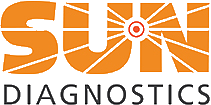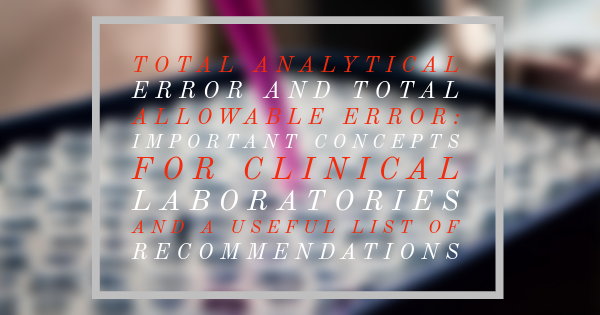You have likely read method performance information with an arbitrary acceptance criterion e.g. plus or minus 10%. This is unfortunate because different measurands differ in the magnitude of error that impacts clinical decision making. Troponin, for example, needs to be measured more accurately and precisely than, let’s say, lactate dehydrogenase (LDH).
Westgard and colleagues introduced the concept of total analytical error (TAE) way back in 1974 to improve the practice of judging method performance. They noted that it was a better practice to judge total error rather than accuracy and precision separately; A method that is very precise can tolerate greater inaccuracy and vice versa. When we add up all errors associated with an assay, we have calculated the total analytical error. A related concept is Allowable Total Error (ATE), although TEa is probably a better abbreviation to avoid confusion with Total Analytical Error. The ATE is the maximum analytical error we can tolerate and still detect clinically useful differences in results. Or, in other words, maintaining the clinical utility of the test.
We can now discuss the allocation of Allowable Total Error to specific sources of error as a means of better maintaining assay performance− an “error budget”. As a first step, we need to define Allowable Total Error for each of our assays. It is reasonable for the Laboratory Director, perhaps with clinical colleagues, to define these limits. Better yet is to rely on CLIA regulations, external proficiency testing programs, performance goals based on biological variation, and/or goals from professional organizations and expert committees. Once we have defined ATE, we can allocate allowable error to different sources of error. For potential sources of bias, such as calibrator lot changes, reagent lot changes, and multi-instrument comparison, a reasonable allowable error is <1/4 of the total allowable error. Remember, we typically need to leave the bulk of our error budget — the total allowable error — for random variability. Without getting into a detailed discussion of QC rules, optimal error detection requires our quality control standard deviations to be relatively small compared to total allowable error. We want to allocate at least 2/3 or, better yet, 3/4 of our error budget to QC (random variability).
Finding ATE recommendations can be difficult; therefore, we have compiled a relatively comprehensive list. Although we try our best to double-check and update this table, you may find some additions, corrections, and updates needed. Please let me know so we can make any corrections needed. The sources we used to construct the Table are provided below. I hope you find this Table and this blog regarding total allowable error useful.
SOURCES:
1. CLIA, CFR Part 439; http://www.cdc.gov/clia/
2. College of American Pathologists (CAP), Proficiency Testing Surveys.
3. New York State Dept. of Health (NYSDOH) Clinical Laboratory Evaluation Program. http://www.wadsworth.org/regulatory/clep
4. Desirable specifications for allowable total error, based on biological variability (BV): https://www.westgard.com/biodatabase1.htm
5. Royal College of Physicians of Australasia (RCPA) Quality Assurance Program
6. American Association of Bioanalysts (AAB)
7. Wisconsin State Laboratory of Hygiene (WLSH)
8. Canadian Fixed limits (CFX) from the College of Physicians and Surgeons of Saskatchewan.
9. National Cholesterol Education Program: Recommendations for improving cholesterol measurement. a report from the Laboratory Standardization Panel of the National Cholesterol Education Program. NIH Publication No. 90-2964, Bethesda, Maryland, February 1990.
10. Bachorik PS, Ross JW, for the NCEP Working Group on Lipoprotein Measurement. National Cholesterol Education Program recommendations for measurement of low-density lipoprotein cholesterol: executive summary. Clin Chem 1995; 41:1414-20.
11. Stein EA, Myers GL, for the NCEP Working Group on Lipoprotein Measurement. National Cholesterol Education Program recommendations for triglyceride measurement: executive summary. Clin Chem 1995; 41:1421-6.
12. Warnick GR, Wood PD, for the NCEP Working Group on Lipoprotein Measurement. National Cholesterol Education Program recommendations for measurement of high-density lipoprotein cholesterol: executive summary. Clin Chem 1995; 41:1427-33.
13. National Glycohemoglobin Standardization Program (NGSP), www.ngsp.org.
14. Myers GL, Miller WG, Coresh J, Fleming J, Greenberg N, Greene T, et al. Recommendations for improving serum creatinine measurement: a report from the Laboratory Working Group of the National Kidney Disease Education Program. Clin Chem 2006; 52: 518.

